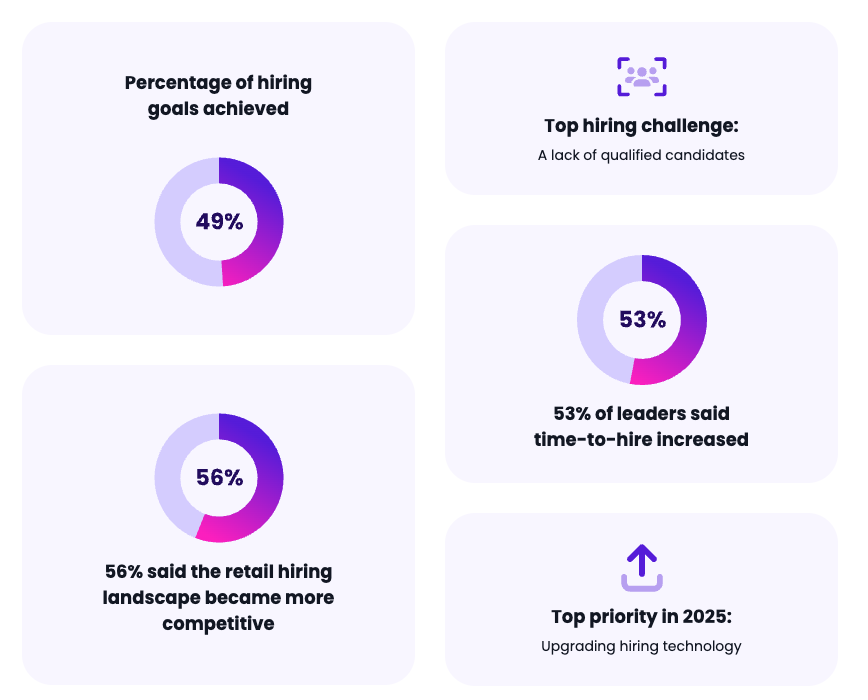Editor’s note: The article below is an excerpt from GoodTime’s 2025 Hiring Insights Report. The entire report is available to view online for free here.
If one thing’s certain amid the hiring landscape’s uncertainty, it’s that retail recruiting won’t get any easier. Recruiters face a multitude of obstacles in the path ahead, including a constant stream of vacancies, high turnover rates, holiday and seasonal hiring demands, and the pressures that come with high-volume hiring.
What’s clear is that the stakes have never been higher. Candidates today expect transparency, personalization, and responsiveness at every stage of the hiring process, and businesses that fail to deliver risk losing top talent to competitors. At the same time, retail hiring teams are constrained by outdated technologies, inefficient workflows, and high recruiter turnover—challenges that threaten to slow hiring efforts and derail growth goals.
This section of our report explores the key trends, challenges, and opportunities that defined retail hiring in 2024 and outlines strategies for addressing them in 2025. From leveraging technology to streamline hiring workflows to building stronger candidate connections, retail talent leaders have a clear path forward to strengthen their processes, reduce inefficiencies, and remain competitive in an increasingly demanding labor market.

Unlock retail’s top hiring strategies in 2025
Our study of 105 retail TA leaders reveals how to hit your hiring goals in a challenging market.

Executive summary: Key retail recruiting stats for 2025

- Percentage of hiring goals achieved: 49%
- Top hiring challenge: A lack of qualified candidates
- 53% of leaders said time-to-hire increased
- 56% said the retail hiring landscape became more competitive
- Top priority in 2025: Upgrading hiring technology
Looking back at 2024: A challenging year for retail hiring
The retail sector faced a significant step back in 2024, achieving only 49% of its hiring goals—down from 58% in 2023. This decline was driven by persistent challenges retail hiring leaders grappled with amidst an increasingly squeezed talent market. Below, we explore the key hiring hurdles that defined the past year, as well as their implications for the sector.
A talent shortage amid high turnover
Retail hiring leaders cited the lack of qualified candidates as the top challenge in 2024, affecting a third of respondents. This was compounded by equally pressing issues like retaining top talent (32%) and technological limitations within existing hiring processes (32%). These challenges reduced the pool of qualified candidates, further exacerbating high turnover rates—an enduring pain point for an industry that thrives on a steady, reliable workforce.
Additionally, the scale of high-volume hiring in retail presents a significant challenge. Many organizations face the task of filling hundreds or even thousands of roles annually, often within tight seasonal windows. The demand for rapid hiring at this scale intensifies the strain on recruiting teams and amplifies the impact of limited talent pools and inefficient processes.
The dual burden on retail managers
A unique challenge in retail hiring stems from the overextension of store managers. Beyond managing day-to-day operations, many are tasked with hiring and retaining talent—a responsibility that is time-intensive and often secondary to their operational duties. As a result, inefficiencies in hiring processes, such as inadequate training for hiring managers and outdated technology, directly impact a store’s ability to maintain adequate staffing levels.
The limits of current hiring technology
Hiring technology in the retail sector often fell short of supporting hiring goals. Limitations in tech were cited by 32% of retail leaders, while inefficiencies in automating repetitive tasks left hiring managers bogged down with administrative work. This reflects a broader trend in which technology adoption in retail lags behind other industries, slowing the sector’s ability to innovate and respond to candidate demandss—especially in high-volume hiring environments where speed and efficiency are critical.
Hiring process bottlenecks exacerbated issues with a shortage of qualified retail talent
In 2024, over half of retail hiring leaders reported an increase in time-to-hire, which exacerbated a broader struggle to balance high turnover and a shrinking talent pool with the operational demands of managing retail locations.
The top bottlenecks driving these delays in time-to-hire paint a clear picture of inefficiencies within the retail hiring process. Frequent interview cancellations, scheduling delays, and slow decision-making from overburdened hiring managers have created significant barriers to securing talent. Poor communication with candidates further compounds these issues, leading to disengagement and higher dropout rates.
These inefficiencies are particularly harmful in an industry reliant on speed and high-volume hiring. To regain momentum, retail leaders must prioritize solutions that automate repetitive tasks, streamline scheduling, and improve communication at every stage. By reducing these bottlenecks, the retail sector can better compete for top talent in an increasingly tight labor market.
The retail hiring landscape became markedly more competitive in 2024, with increased demand for talent straining already stretched recruitment teams. High turnover within recruitment itself further weakened teams’ ability to manage candidate pipelines, while growing candidate demands added complexity by increasing the number of touchpoints required to keep candidates engaged throughout the hiring process.
Amid this challenging environment, building meaningful relationships with candidates emerged as a top priority. Retail hiring leaders emphasized the need to connect quickly and authentically, as delays or lack of engagement risked losing candidates to competitors. The increasing need to fill funnels with more candidates—combined with a heightened dropout rate—showed how essential it is to adapt hiring strategies for speed, personalization, and scalability.
Human-centric AI to crush your high-volume hiring goals
Engage candidates immediately via SMS and WhatsApp, harness instant bulk scheduling, and automate hiring workflows.

How retail attempted to address hiring challenges in 2024
In 2024, retail organizations prioritized increasing personalization, upgrading hiring technology, and improving efficiency to tackle mounting hiring challenges.
These efforts aimed to create a seamless candidate experience while addressing persistent bottlenecks. Improving offer acceptance rates and standardizing hiring processes were also key focus areas.
Automation and AI were integral to these improvements, with retail teams using them to draft candidate communications, schedule interviews, and generate insights from their data. AI-powered tools like chatbots and resume screening further reduced administrative burdens, allowing recruiters to focus on building relationships and making strategic decisions.
These initiatives marked progress toward more efficient hiring, but retail leaders will need to continue refining their processes to address lingering inefficiencies and remain competitive.
“Augment your work with AI, don’t replace the quality of your interaction with other people. Don’t do interviews via AI, but book them, set up your administrative structure via AI. That’s much more helpful than trying to replace yourself.”
-Thomas Waldman, Global Head of Talent Acquisition & Contingent Workforce, Action
Building a fast and simple recruiting process for candidates
Retail organizations increasingly prioritized candidates in 2024, with transparency and streamlined scheduling emerging as key enablers of a better candidate experience. Offering candidates the ability to reschedule interviews automatically through tech-enabled platforms was a critical advancement, as it minimized delays and improved flexibility. Fast interview-to-offer timelines and automated scheduling at candidates’ convenience further reinforced the role of technology in optimizing the hiring process. These innovations, combined with AI-driven tools highlighted in the previous section, demonstrate how retail leaders are leveraging automation to enhance the recruitment journey for candidates and hiring teams alike.
How retail hiring teams measure success
Retail hiring teams continued to focus on recruitment metrics tied to efficiency and effectiveness in 2024, with quality of hire (52%) and time-to-hire (51%) leading as the most frequently measured KPIs. These metrics align with the sector’s emphasis on reducing hiring delays and quickly filling a high volume of open roles to keep operations running smoothly. Time-to-hire remains a critical metric in retail, where staffing gaps can directly impact day-to-day business performance.
However, the relatively low measurement of candidate interview experience (25%) is surprising, given the widespread acknowledgment of its importance in attracting and retaining top talent.
This gap highlights an opportunity for retail teams to integrate candidate feedback into their hiring processes. By leveraging automation and building dashboards that track candidate experience in real-time, hiring leaders can gain actionable insights while maintaining the efficiency needed to compete in today’s market. Enhanced visibility into candidate perceptions would not only improve experiences but also strengthen overall hiring strategies.
How retail talent leaders are gearing up for 2025
The retail hiring landscape in 2025 is expected to grow even more competitive, with increased demand for talent and high recruitment team turnover emerging as key factors. Hiring leaders anticipate a need for larger candidate funnels and faster connections with applicants to meet growing demands.
In addition to systemic changes, retail hiring teams expect several familiar challenges to persist. Hybrid work complexities, candidates with multiple offers, and retaining top talent remain significant concerns. The sector is also preparing to deal with a rise in candidate dropouts, mismatched skill sets, and suboptimal employer branding—all of which could further disrupt hiring timelines. Addressing these challenges will require not only efficient processes but also innovative use of technology.
A tech-enabled revolution is on the horizon in the sector
Retail leaders are prioritizing upgrading hiring technology (39%) as their top focus for 2025, recognizing its critical role in addressing inefficiencies and evolving candidate expectations.
Improving time-to-hire (36%) and building relationships with candidates (36%) also rank high, emphasizing the need for faster, more personalized hiring processes. Additionally, initiatives like standardizing the hiring process (33%) and reducing cost-per-hire (33%) highlight a focus on balancing efficiency with cost control.
Final thoughts and key takeaways
This year, the retail talent leaders highlighted significant challenges—from talent shortages and extended time-to-hire to inefficiencies in scheduling and candidate engagement. As competition for top talent intensified, the sector leaned on technology and automation to address bottlenecks and improve the overall hiring experience. However, persistent issues such as high recruitment team turnover, candidate dropouts, and mismatched skill sets reaffirmed the need for continued innovation and agility.
Looking ahead to 2025, retail leaders should prioritize:
- Investing in hiring technology: Upgrading tools to streamline workflows, optimize scheduling, and enhance communication will be critical in reducing time-to-hire and improving efficiency.
- Enhancing candidate engagement: Personalization, transparency, and fast interview processes will help attract and retain top talent in an increasingly competitive market
- Strengthening recruiter and hiring manager capacity: Standardizing workflows and leveraging automation can ease the burden on overextended teams while maintaining high hiring standards.
- Focusing on metrics that matter: Measuring candidate experience alongside efficiency metrics like time-to-hire will provide valuable insights to refine processes and deliver a competitive edge.




